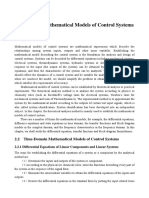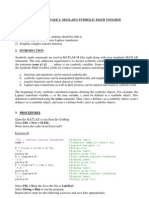SymPy Cheatsheet
Uploaded by
Taimoo NaseemSymPy Cheatsheet
Uploaded by
Taimoo NaseemSymPy Cheatsheet (http://sympy.
org)
Basics Geometry Examples
Sympy help: help(function) Points: a = Point(xcoord, ycoord) Find 100 digits of π e :
Declare symbol: x = Symbol(’x’) Lines: l = Line(pointA, pointB) (pi**E).n(100)
Substitution: expr.subs(old, new) Circles: c = Circle(center, radius)
Numerical evaluation: expr.evalf() Triangles: t = Triangle(a, b, c) Expand (x + y)2 (x − y)(x2 + y):
Expanding: expr.expand() Area: object.area ((x + y)**2 * (x - y) * (x**2 + y)).expand()
Common denominator: ratsimp(expr) Intersection: intersection(a, b)
Simplify expression: simplify(expr) 1 x sin x − 1
Checking tangency: c.is_tangent(l) Simplify + :
x x2 − 1
simplify((1/x) + (x * sin(x) - 1)/(x**2 - 1))
Constants Numbers types Plotting
Check if line passing through points (0, 1) and (1, 1)
π: pi Integers (Z): Integer(x) Plot: Plot(f, [a, b])
is tangent to circle with center at (5, 5) and radius 3:
e: E Rationals (Q): Rational(p, q) Zoom: +/−: R/F or PgUp/PgDn or Numpad +/-
Circle(Point(5,5), 3).is_tangent(
∞: oo Reals (R): Float(x) Rotate X,Y axis: Arrow Keys or WASD
Line(Point(0,1), Point(1,1)))
i: I Rotate Z axis: Q and E or Numpad 7 and 9
View XY: F1
Find roots of x4 − 4x3 + 2x2 − x = 0:
Basic funtions View XZ: F2
solve(x**4 - 4*x**3 + 2*x**2 - x, x)
View YZ: F3
Trigonometric: sin cos tan cot View Perspective: F4
Cyclometric: asin acos atan acot Solve the equations system: x + y = 4, xy = 3:
Axes Visibility: F5
Hyperbolic: sinh cosh tanh coth solve([x + y - 4, x*y - 3], [x, y])
Axes Colors: F6
Area hyperbolic: asinh acosh atanh acoth Screenshot: F8 √
n
Exponential: exp(x) Calculate limit of the sequence n:
Exit plot: ESC
Square root: sqrt(x) limit(n**(1/n), n, oo)
Logarithm (logb a): log(a, b)
Discrete math |x|
Natural logarithm: log(a) Calculate left-sided limit of the function x
in 0:
Gamma (Γ(x)): gamma(x) Factorial (n!): factorial(n) limit(abs(x)/x, x, 0, dir=’-’)
( )
Absolute value: abs(x) Binomial coefficient nk : binomial(n, k) ∑
∑ Calculate the sum 100 2
Sum ( bn=a expr): summation(expr, (n, a, b)) n=0 n :
∏ summation(n**2, (n, 0, 100))
Calculus Product ( bn=a expr): product(expr, (n, a, b))
∑
lim f (x):
x→a
limit(f, x, a) Calculate the sum ∞ 1
n=0 n2 :
Linear algebra summation(1/n**2, (n, 0, oo))
lim f (x): limit(f, x, a, dir=’-’)
x→a−
lim f (x): limit(f, x, a, dir=’+’)
Matrix definition: m = Matrix([[a, b], [c, d]]) ∫
x→a+ Determinant: m.det() Calculate the integral cos3 x dx:
d integrate(cos(x)**3, x)
dx
f (x): diff(f, x) Inverse: m.inv()
∂
∫ f (x, y):
∂x
diff(f, x) Identity matrix n × n: eye(n) ∫∞
f (x) dx : integrate(f, x) Zero matrix n × n: zeros(n) Calculate the integral 1 xdx2 :
∫b
a
f (x) dx : integrate(f, (x, a, b)) Ones matrix n × n: ones(n) integrate(1/x**2, (x, 1, oo))
Taylor series (at a, deg n) f.series(x, a, n)
1
Find 10 terms of series expansion of at 0:
Printing 1−2x
(1/(1 - 2*x)).series(x, 0, 10)
Equations LATEX print: print latex()
′′
Equation f (x) = 0: solve(f, x) Python print: print python() Solve the differential equation f (x) + 9f (x) = 1:
System of equations: solve([f, g], [x, y]) Pretty print: pprint() dsolve(f(x).diff(x, x) + 9*f(x) - 1, f(x))
Differential equation: dsolve(equation, f(x))
You might also like
- PosiStrut Floor and Roof Installation InstructionsNo ratings yetPosiStrut Floor and Roof Installation Instructions28 pages
- (BROOKS) CalcLabs With Mathematica For Stewart's Multivariable Calculus-Brooks Cole (2007)No ratings yet(BROOKS) CalcLabs With Mathematica For Stewart's Multivariable Calculus-Brooks Cole (2007)292 pages
- C4 Integration Cheat Sheet: How To Deal With It How To Deal With ItNo ratings yetC4 Integration Cheat Sheet: How To Deal With It How To Deal With It1 page
- Object Oriented Programming InheritanceNo ratings yetObject Oriented Programming Inheritance34 pages
- Download full MATLAB Programming for Engineers 5th Edition Chapman Solutions Manual all chapters100% (4)Download full MATLAB Programming for Engineers 5th Edition Chapman Solutions Manual all chapters47 pages
- Electromagnetik Fields and Waves Iskander Solution Manual PDF0% (1)Electromagnetik Fields and Waves Iskander Solution Manual PDF185 pages
- Matlab Matlab Toolbox Deep Learning Toolbox Neural Network Toolbox Libraries Functions How To UseNo ratings yetMatlab Matlab Toolbox Deep Learning Toolbox Neural Network Toolbox Libraries Functions How To Use5 pages
- Computational-tools-and-software-MATLAB-PythonNo ratings yetComputational-tools-and-software-MATLAB-Python5 pages
- David J. Griffiths - Introduction To Electrodynamics - Instructor's Solutions Manual 1999100% (1)David J. Griffiths - Introduction To Electrodynamics - Instructor's Solutions Manual 1999253 pages
- Immediate download Engineering Fluid Mechanics 10th Edition Elger Solutions Manual all chapters100% (4)Immediate download Engineering Fluid Mechanics 10th Edition Elger Solutions Manual all chapters42 pages
- 14 Fourier Integral Fourier Transform (Zill, Dennis G) ..No ratings yet14 Fourier Integral Fourier Transform (Zill, Dennis G) ..21 pages
- Block Diagram, Signal-Flow Graphs, Mason's RuleNo ratings yetBlock Diagram, Signal-Flow Graphs, Mason's Rule84 pages
- Basic Engineering Sciences Reviewer - CompleteNo ratings yetBasic Engineering Sciences Reviewer - Complete87 pages
- Handouts of Maxima Software For Mathematics PracticalNo ratings yetHandouts of Maxima Software For Mathematics Practical5 pages
- Full Download Instant SymPy Starter 1st Edition Ronan Lamy PDF100% (9)Full Download Instant SymPy Starter 1st Edition Ronan Lamy PDF60 pages
- Symbolic and Automatic Di Erentiation in Python: Some Convenient ToolsNo ratings yetSymbolic and Automatic Di Erentiation in Python: Some Convenient Tools9 pages
- Shear Deflection of Composite Wood BeamsNo ratings yetShear Deflection of Composite Wood Beams12 pages
- Differential geometry of manifolds Second Edition Lovett 2024 scribd downloadNo ratings yetDifferential geometry of manifolds Second Edition Lovett 2024 scribd download55 pages
- The Five Generic Competitive StrategiesNo ratings yetThe Five Generic Competitive Strategies39 pages
- Initiate and Complete A Journal Entry Document Via Park Document (Document Types SA or ZB)No ratings yetInitiate and Complete A Journal Entry Document Via Park Document (Document Types SA or ZB)18 pages
- 01- 24 MLD STP Bijnor Power Consume Report January-2025No ratings yet01- 24 MLD STP Bijnor Power Consume Report January-20251 page
- ACCOUNTING GR12 Control Test MEMO - 13 MARCH 2025No ratings yetACCOUNTING GR12 Control Test MEMO - 13 MARCH 20255 pages
- Siemens Simatic S7-1200 - PLC-City - PLC-CityNo ratings yetSiemens Simatic S7-1200 - PLC-City - PLC-City12 pages
- Jingjiao The Church of The East in China and Central AsiaNo ratings yetJingjiao The Church of The East in China and Central Asia711 pages
- 24by09in00002376 - Sky Ventureszdup - 27-07-2024No ratings yet24by09in00002376 - Sky Ventureszdup - 27-07-20242 pages
































































































